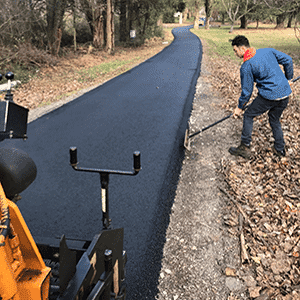When you’re trying to decide between asphalt pavement and concrete for that next big paving project you have in mind, there are a few factors you should consider. These ideas may help you to reach the right decision for your circumstances. Here are some of the most important considerations to keep in mind when you’re trying to choose just the right paving material for your project.
Climate for your area
One of the first things you should seriously consider is the climate where the paving project will take place. In a northern climate where winters tend to be harsh, there’s no question that asphalt is a better material to use for parking lots, roadways, and driveways. Concrete is susceptible to expansion and contraction as well as frost heaves, and that will inevitably lead to damage and deterioration. Concrete will also degrade with salt use, and most northern climates use salt on the roadways to manage snow and ice.
Asphalt on the other hand, does not deteriorate when salt is applied to it, nor is it affected by cold weather. In fact, asphalt pavements will absorb much more heat from the sun, and that will allow snow and ice to melt much faster on the surface than they will on concrete. In areas where the temperature tends to be relatively warm, even through the winter months, concrete may be a better material for your paving project. In extreme heat, asphalt will soften and sometimes become oily on top, and that doesn’t happen with concrete.
Ease of installation and general maintenance
Asphalt is often thought to be superior to concrete for a number of different paving projects, simply because it’s considerably easier to work with than concrete is. It can be installed and used much more easily and much more quickly than concrete can. Whenever pavement needs to be maintained or replaced, it’s only the top layer that requires repaving. The middle and base layers are both considered to be permanent, and that can make it a much more cost-effective material to use than concrete.
It’s also true that concrete currently costs approximately 35% more than pavement, so if you want to choose the most cost-effective material, that would be asphalt. It’s possible that you will need more preventive maintenance when using asphalt for your paving project, but this will have the effect of keeping your asphalt looking new and being more functional for a longer period of time. Concrete quickly loses its new look, but it does tend to require less preventive maintenance than asphalt.
Environmental impact
Asphalt is one of the most environmentally-friendly materials on earth, given the fact that it is extremely recyclable, and can be reused an endless number of times. The recycling process simply involves grinding up the old asphalt, remixing it, and then re-applying it to whatever surface is being paved. Concrete is not nearly so friendly to the environment, because it will usually have to be broken up, hauled away, and disposed of, either in some kind of landfill or in an environmentally approved facility.
Some kinds of asphalt promote water drainage by allowing the water to percolate right through the pavement, into the ground area below it. These types of asphalt are known as porous or permeable pavement, and they can be extremely effective at avoiding pooling or ponding on the surface because water will percolate right through them. Concrete road surfaces lack this ability, and when water is present on the surface, it will either have to pond up right on the surface, or run off to the sides and into the local water table.







